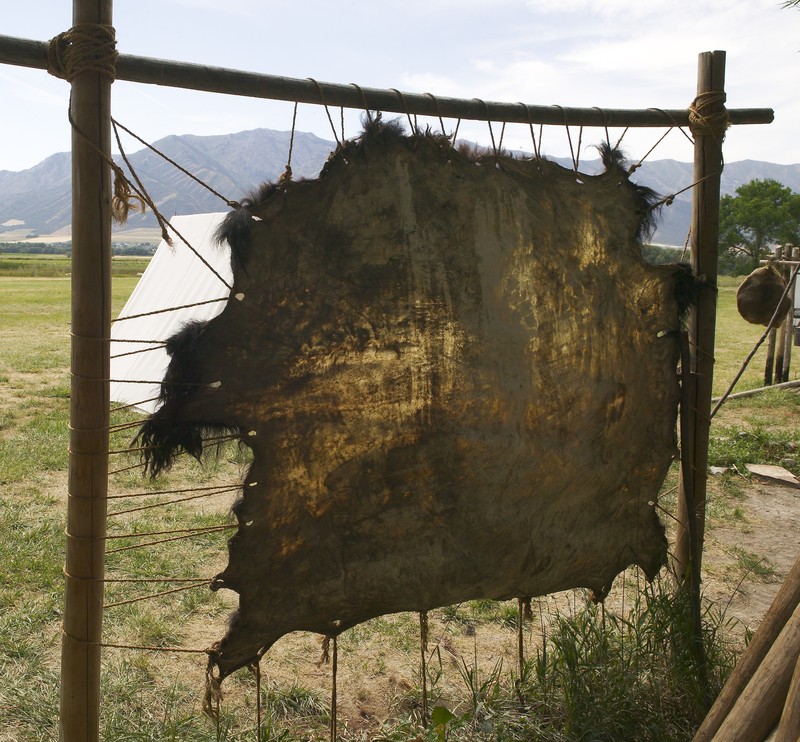Today, providing for yourself means having the money to buy everything you need. About a hundred years or so ago, providing for yourself meant making everything you need. You'll want to know what skills were most valuable back then, because when SHTF they'll certainly be valuable again.
Tan Hides With Brains
Before the invention of chemical tanning to create leather, animal skins were subjected to all kinds of strange concoctions to degrease and soften them. Urine, wood ashes, tree bark acid, and even toxic substances like mercury have been employed over the centuries to tan skins into useful leather. These all have their uses, but few natural substances have had such a long and successful track record (or are as odd to work with) as animal brains to tan hides.
Build a Trap Line
Trapping was a common means for American mountain men to collect valuable furs and feed themselves at the same time. Traps can be purchased or hand built today, just as they once were. Traps should be de-scented to remove human scent and the proper baits should be selected to attract your target species. Check your trap line daily.
Use Flint & Steel
When you strike a piece of high-carbon steel against a hard, sharp stone edge (like a flake of flint), you can create a red-hot spark. These sparks come from the carbon in the steel, and are created by any sharp stone that is harder than the steel.
Make Your Own Medicine
To our forebears living in remote areas, the local wild plants had to serve double-duty as food and medicine. Making one’s own medicine was a well-known practice centuries ago, but it has fallen into obscurity since the advent of the corner drug store. Even the word “drug” is anchored in the past: It comes from the old Dutch word “droog,” which means dried plant.
Twist Up Some String
There never seems to be enough cordage, rope, or string to go around. Unless you can make your own, that is. If you are fortunate enough to have some fibrous raw material and you know cord production, you should be able to crank out string and heavier cord without any trouble.
Learn Your Lashings
In order to build certain shelters (like wigwams) and most camp furniture, you’ll have to learn your lashings. The folks living a pioneer life on the American frontier knew all about lashings. By joining sticks to other sticks, they were able to create fences to keep in livestock, build handy structures for camp and farm, and even erect lookout towers to keep an eye out for hostile neighbors.
Cook Your Own Meals
With a lack of drive-thrus and other dining options, our forerunners had to cook for themselves all the time. This daily grind was absolutely necessary and generally for subsistence, not for flavor. They ate to live, they didn’t live to eat.
Make Some Weapons
On average, ancestral life was short and harsh. Don’t ever get a romanticized version of history in your head. Our predecessors rarely felt safe. There was always a group nearby who either wanted their stuff or wanted them gone. If armaments were in short supply, our progenitors had to make them.
Mend Your Own Gear
In frontier times, if you wanted something that didn’t grow from the earth, you had to make it. And once you made something, you didn’t want to make it again, so you had to know how to repair what little you had. This meant sewing, woodworking, smithing, and a host of other skills.
Learning these skills and practicing them on a regular basis is important. While you certainly don't want to have to rely on self-sufficiency (people also died a lot more often back then, too), having the skills to a fall-back plan can't hurt your chances.
Learn the local plants and their uses. Practice using every scrap of an animal when you go hunting. Practice with flint and steel whenever possible (real flint and steel, not Ferro rods) because however difficult you think it is, we promise it's ten times harder than that.
As for lashings; practice, practice, practice. There is a multitude of knots for a reason: they have a myriad of uses. If one knot were good for everything, then there would only be one knot. Pick up a book at the library to learn some more of these old skills.
If you'd like to read the whole article and soak up more traditional survival advice, check out Outdoor Life.

good info, but not many people know how to make tanned leather soft enough to work it, or how to work with leather once its tanned.
Pretty messed up browser hijacking link connected. It tried to keep me from continuing without accepting some BS software from them, started a loud beeping coming from my speakers. I was able to escape it but I don’t think I’ll try clicking on another link from these guys if that’s what I can expect….